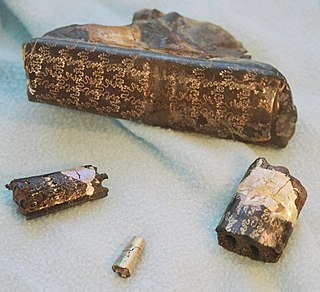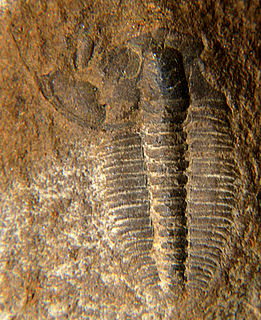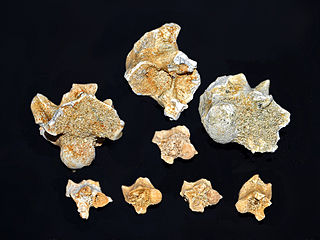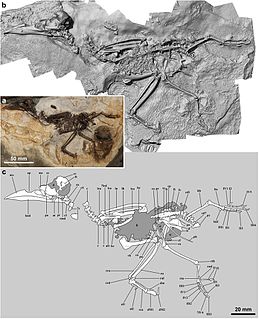 W
WAigialosuchus is a genus of long-snouted crocodylomorph that lived in what is now Sweden during the Campanian stage of the Late Cretaceous period and possibly in what is now Denmark during the Paleocene stage of the Paleogene period. The name Aigialosuchus comes from the Greek αἰγιαλός (aigialos), meaning "seashore", and σοῦχος (souchus), meaning "crocodile". The genus contains a single species, A. villandensis, described in 1959 by Per Ove Persson based on material recovered from the Kristianstad Basin in southern Sweden.
 W
WBaculites is an extinct genus of cephalopods with a nearly straight shell, included in the heteromorph ammonites. The genus, which lived worldwide throughout most of the Late Cretaceous, was named by Lamarck in 1799.
 W
WEosphargis is an extinct genus of sea turtles from the Eocene of Africa, Europe, and North America. It was first named by Richard Lydekker in 1889, and contains one species, E. gigas. The species is also known as Anglocetus beatsoni.
 W
WForficula paleocaenica, is a fossil species of earwigs, of the family Forficulidae. It was found in Denmark, dating to the Eocene.
 W
WOlenus is a genus of Upper Cambrian ptychopariid trilobite.
 W
WPalaeophis is an extinct genus of marine snake that is the type genus of the extinct snake family Palaeophiidae.
 W
WParaorthacodus is an extinct genus of cartilaginous fish. An unidentified species has been found in the Hasle Formation of Bornholm, Denmark.
 W
WPhalagnostus is a genus of small trilobites, in the order Agnostida. It lived during the Middle Cambrian, in what are now Canada, China, the Czech Republic, Denmark, England, France, the Russian Federation, Wales, Sweden, and possibly the United States (Vermont). The headshield is almost entirely effaced and wider than the tailshield. The pygidium is also very effaced, but the ovate pygidial axis is well defined and a border furrow is also present.
 W
WPlanolites is an ichnogenus found throughout the Phanerozoic that is made during the feeding process of worm-like animals. The traces are generally small, 1–5 mm (0.039–0.197 in), unlined, and rarely branched, with fill that differs from the host rock.
 W
WSeptencoracias is an extinct genus of bird related to modern rollers and other Coraciiformes such as kingfishers, bee-eaters, motmots, and todies. It contains one species, Septencoracias morsensis. It was found in the Fur Formation of Denmark, dating back to the Ypresian of the Lower Eocene Epoch, about 54 million years ago. Septencoracias is one of the earliest known members of Coraciiformes, lending insight into the earliest radiation of this group.
 W
WSphaeragnostus is an extinct genus from a well-known class of fossil marine arthropods, the trilobites. It can be recognized by having two thorax segments, a totally effaced headshield, while the tailshield although effaced, has a clear furrow parallel to its border, and a short, convex, subcircular axis. It lived during the Ordovician.
 W
WTasbacka is an extinct genus of sea turtle containing several species.
 W
WToragnostus is a genus of trilobites restricted to the late Middle Cambrian. Its remains have been found in the United States, Greenland, Denmark, China, Sweden, the Russian Federation, and Kazakhstan. Its headshield and tailshield are almost completely effaced and it has two thorax segments.
 W
WTrinodus is a very small to small blind trilobite, a well known group of extinct marine arthropods, which lived during the Ordovician, in what are now the Yukon Territories, Virginia, Italy, Czech Republic, Poland, Denmark, Sweden, Svalbard, Ireland, Scotland, Wales, Iran, Kazakhstan and China. It is one of the last of the Agnostida order to survive.
 W
WUsomyrma is an extinct genus of ant in the formicid subfamily Dolichoderinae. The genus contains a single described species, Usomyrma mirabilis, that is known from two Middle Eocene fossils which were found in Scandinavian amber in Denmark.
 W
WYpresiomyrma is an extinct genus of ants in the subfamily Myrmeciinae that was described in 2006. There are four species described; one species is from the Isle of Fur in Denmark, two are from the McAbee Fossil Beds in British Columbia, Canada, and the fourth from the Bol’shaya Svetlovodnaya fossil site in Russia. The queens of this genus are large, the mandibles are elongated and the eyes are well developed; a stinger is also present. The behaviour of these ants would have been similar to that of extant Myrmeciinae ants, such as solitary foraging for arthropod prey and never leaving pheromone trails. The alates were poor flyers due to their size, and birds and animals most likely preyed on these ants. Ypresiomyrma is not assigned to any tribe, and is instead generally regarded as incertae sedis within Myrmeciinae. However, some authors believe Ypresiomyrma should be assigned as incertae sedis within Formicidae.